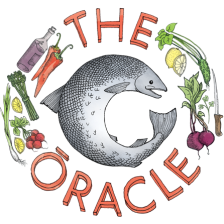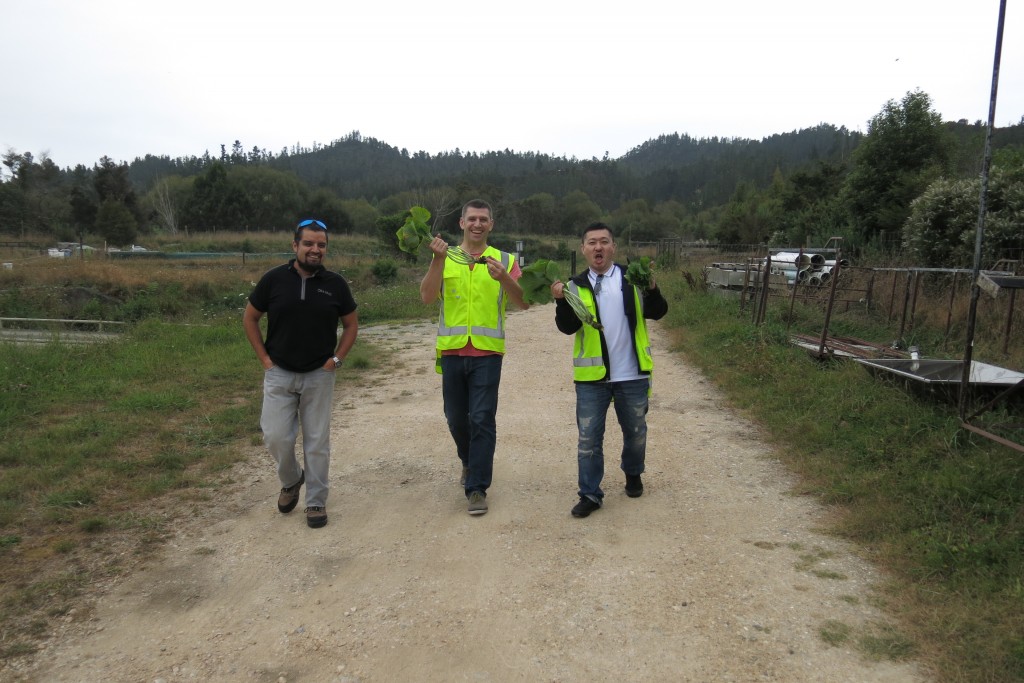ŌRA KING – WHERE THE MAGIC BEGINS
By Darren Johnson, Executive Chef, MASU by Nic Watt
The big day is finally here. After two months of planning and phone conversations with people in London, I organised a guest appearance at Masu of old friend and work colleague Endo Kazutoshi. Endo is a third generation sushi chef and sushi master in the eyes of many. He is here to work his magic at Masu for a limited time and we’ve got a busy schedule.
Once checked in at the Grand Hotel at SKYCITY, Endo meets me in the restaurant for a brief catch up and a run-down of events for the coming week, followed by dinner with Nic then a well needed sleep for an early start the next day.
Nelson
I’m putting him on another flight in the morning but one I think he will enjoy as it’s a short one; we’re heading to Nelson to visit the Ōra King hatchery and the home of NZ King Salmon.
After a busy night at the restaurant I head home and pack a few things for the trip to Nelson (shark skin paddle for grating wasabi, fish tweezers, soy sauce, cannot forget the camera) and head for bed. Its 12:30am. Big day tomorrow.
05:30 am comes around far too fast, my eyes are heavy. I shower, shave and grab a cup of tea. I’m out the door – I need to pick up Endo at the front of the hotel by 06:30.
“Morning, how did you sleep?” I greet Endo. “Great! I was in bed by 9 o’clock”.
“Awesome,” I reply, pushing aside my tiredness.
I’m excited. “It’s going to be a great day – I get to show you one of the most beautiful parts of New Zealand.”
We board the plane. We’re on our way. Endo, with the window seat, wants to take in everything the view has to offer – it doesn’t disappoint. The Southern Alps come in to view as we descend. Once we land, the Ōra King hatchery is around an hour’s drive from Nelson in Golden Bay.
First contact
I first tasted this beautiful King salmon when I was Head Chef at Roka, London and couldn’t believe the flavour and the texture. It has a very clean after taste. The fish just melts in the mouth. I’ve been using Ōra King salmon on the menu at Masu since we opened back in 2013 and it’s one of our biggest sellers.
Jemma Mc Cowan, Marketing guru from Ōra King greets us at the gate and we set off for the scenic drive ahead. A few necessary stops to get some amazing raspberries and blackberries (Nelson is renowned for its fruit and hops, a particular personal favourite) and of course coffee. Caffeine on board we are running late for lunch which we are providing.
The drive is breath-taking and a challenge. It has to be one of the windiest roads I have ever been on and climbs straight up for over 25 minutes on a constant rollercoaster ride that levels out at the top before you descend into Golden Bay with amazing views of the mountains stretching to the distance with a gaping valley between. Your ears pop with the sudden change in pressure just like on the plane as we made our way down from altitude.
The hatchery
We arrive at the hatchery 20 minutes later. There is a calmness about this place, the air is sweet and fresh and the water…”Wow” Endo’s only words since arriving (he slept most of the drive) and he’s right they echo my words also…the water is so clear that if it hadn’t been for the watercress wafting in the current I would swear it wasn’t there, so clear and pure “Amazing” (Endo’s second word).
At the gate, we don high vis vests and receive a quick safety brief before introductions to the rest of the small but dedicated team – they look hungry. We grab the packed lunch Jemma and her team has put together for us, sides of Ōra King salmon both smoked and fresh, along with bread, cheese, olives, fruit and a couple of salads.
As instructed, Endo has brought his knives and will sort out the fresh salmon for us. But first we want to see the wasabi plants that the team at Ōra King are dabbling in so we can select a rhizome (wasabi root) to go with lunch.
Wasabi is very hard to grow and is a very fussy plant; too much humidity it dies; the wrong nutrient composition it dies; and it is prone to disease. The wasabi at the hatchery is grown in a small plot and looks alive and healthy, it has a constant flow of spring water flowing over the beds which is essential. We choose our rhizome and head back to prepare the rest of the lunch.
Ever the professional, Endo wows the team with his knife skills and arranges the different parts and cuts of the salmon on a serving platter. I’ve added my contribution and grated the fresh wasabi, poured the soy and broken out the chop sticks.
Well-fed and content we are led to a small room by René the Head Scientist. Formerly from Chile, René has had a long career in fish farming, learning his craft in far off places such as Norway and Scotland. He now calls New Zealand home, telling me he couldn’t believe his luck “landing a job in paradise”. Rene starts by showing us a short video of the process of harvesting salmon eggs, impregnating them, and all the way up to the point where the “fry” are sent to Christchurch for further development. We then head out to the hatchery sheds via the source of this amazingly clear and pure spring.
Te Waikoropupu Springs is a sacred place for the local Maori and has great spiritual significance so it is very important to René that the utmost respect to the environment is paid at all times. Ōra King has permission from the local iwi to have the hatchery located here and great care is taken not to upset the balance, with no pumps or machinery fowling the water, disturbance to the springs is very minimal if at all.
The nursery
The first stage of the salmon’s life starts in the incubators. Eggs are placed in large trays and fertilised. For the next 30 days you cannot move the trays even 1 cm or you will lose the lot and have to start over. It’s a nervous time for Rene and his team because if there is a mistake you don’t find out until a month later.
After the salmon has passed this critical stage, the fish start their long journey. Some are destined for the plate and some are kept as breeding stock at the hatchery. The breeding stock are looked after in large holding pens with constant care provided by the team. Feed is also a science that maintains the health of the fish as well as the temperature of the water. It’s at a consistent 11.7 degrees thanks to Mother Nature and the Te Waikoropupu Springs.
The returns for this type of farming? It’s effective. For every kilo of feed protein fed to the salmon, there’s a return of 1.4 kilos of fish. Compare this with wild salmon where it takes 5kg of whole fish to grow 1 kg of salmon.
Amazingly, Ōra King’s breeding programme has been going for 18 years and they have traceability on every fish that can go back five generations.
Endo and I are blown away by the knowledge of the staff and the amount of work that goes into breeding this very special fish. It has been a great experience coming to Nelson to see where this product that I love and use every day at Masu comes from.
Hard work
Farming of any type is a hard job on more than one level. Dealing with whatever Mother Nature throws at you, growing, feed, the health of the animal…the list goes on. I have a strong respect for the Ōra King team. They treat the salmon with the upmost care and attention whilst working in harmony with the environment – and it shows.
It takes a special type of person to dedicate this much time, energy and passion into a worthwhile cause and I’m glad we’ve had the chance to spend this time with them.
And as for Endo san’ I think he feels the same way. Before we leave, Endo and I pay another visit to the wasabi patch to collect a few specimens to use for the upcoming week’s events.
You can be sure that Ōra King Salmon will feature heavily on the sushi master’s menu at Masu.











Leave a Reply